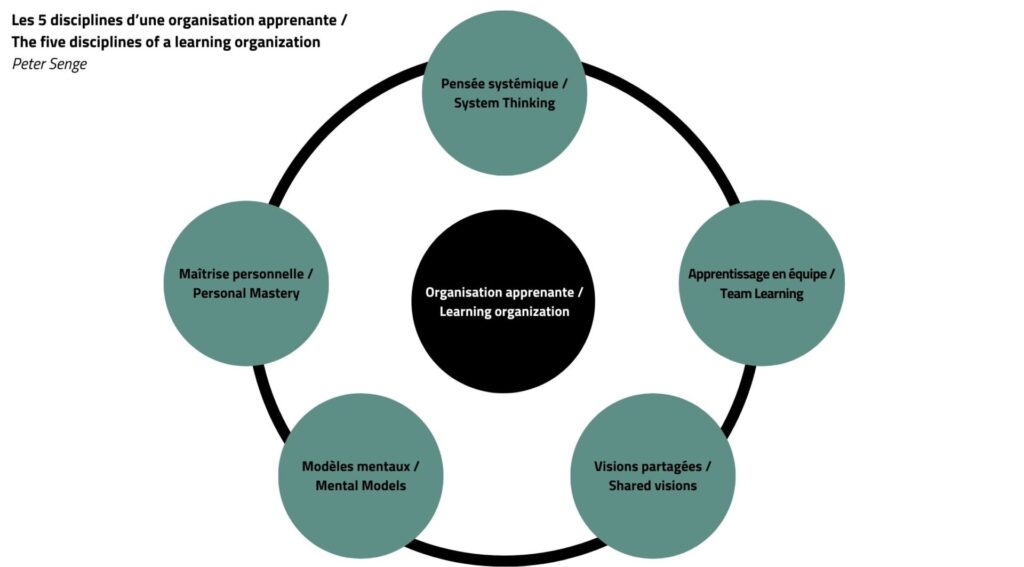This text is a summary and free interpretation of extracts from the article The Learning Organisation and Health Care Education.
Al-Abri RK, Al-Hashmi IS. The learning organisation and health care education. Sultan Qaboos Univ Med J. 2007 Dec;7(3):207-14. PMID: 21748105; PMCID: PMC3074888.
What is a learning organization?
According to the authors Al-Abri and Al-Hashmi, in a learning organisation, health care education aims to educate its members with up to date knowledge to produce competent and safe personnel, who can promote quality in health care services.
Learning organizations are those where people continually expand their capacity to create the results they truly desire, where new and expansive patterns of thinking are nurtured, where collective aspiration is set free, and where people are continually learning to see the whole together.
Peter Senge is an American professor of management and author.
He directs the Center for Organizational Learning at the MIT Sloan School of Management.
In Québec, Marie-Hélène Gilbert, organizational psychologist and full professor in the Department of Management at Université Laval, surveyed over 500 managers in the health and social services sector. She noted the predominance of an organizational culture focused on achieving objectives, indicators and results. Psychological distress at work results from this culture, which she describes as competitive. Indeed, in such a climate, Professor Gilbert points out that managers tend to adopt “a more transactional leadership style, i.e., oriented towards achieving the organization’s objectives, as well as a laissez-faire style, characterized by a lack of support and availability towards their teams”.
Source:
According to Marie-Hélène Gilbert, the solution to improving employee psychological health? Adopt values that focus on people, collaboration and participation (group culture). This disposition also fosters transformational leadership, focused on a shared vision, individual commitment and development, she says.
Favoriser le bien-être des gestionnaires en santé, Fonds de recherche du Québec
Learning continually in order to adapt to changes in the environment and grow
Any organization wishing to implement a learning organization philosophy needs an overall strategy with clear, well-defined objectives. Once these objectives have been defined, it’s time to identify the tools needed to facilitate the strategy.
The building blocks of a learning organization are people, to begin with, and then teams. They share and act on the basis of collective learning.
Such an organization applies an organizational learning cycle in which new knowledge is created, captured, shared and implemented. In a learning organization, managers, supported by HR professionals, play a key role in creating learning opportunities for individuals or teams, and in sharing learning in the workplace.
5 interdependent disciplines
In contrast to the traditional hierarchical model, Peter Senge’s learning organization is based on five essential disciplines:
- Personal Mastery: Clarifying our approach to reality
- This is a matter of personal choice for the individual, and involves constantly and objectively assessing the gap between current and desired skills, and practicing and refining skills until they are internalized.
- Mental Models: Learning to let go of our prejudices
- If group members can constructively challenge each person’s ideas and assumptions, they can begin to recognize their mental models and modify them to build a common mental model for the team
- Shared visions: Linking people together
- For this vision to become reality, everyone in the organization must understand, share and contribute to it. People will then do things out of personal commitment, rather than under external pressure.
- Team Learning: Fostering collective reflection through dialogue
- Thanks to team learning, the group’s ability to learn becomes greater than the ability of each individual member to learn.
- System Thinking: Taking a holistic view of the system
- Systems thinking is fundamental to any learning organization, as it is the discipline used to implement the other disciplines. Without it, each of the disciplines would be isolated and therefore unable to achieve its objective.
- It allows us to examine a system’s interrelationships as opposed to simple chains of cause and effect, enabling us to study continuous processes rather than single snapshots. This discipline also shows us that the essential properties of a system are not determined by the sum of its parts, but by the process of interactions between these parts.

In short, the five factors identified are dynamic in the way they interact with each other. These five disciplines are interdependent.Each discipline cannot stand alone.
